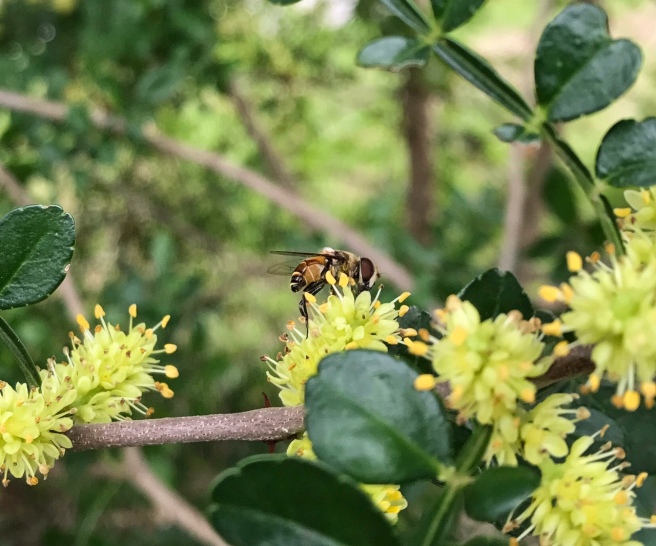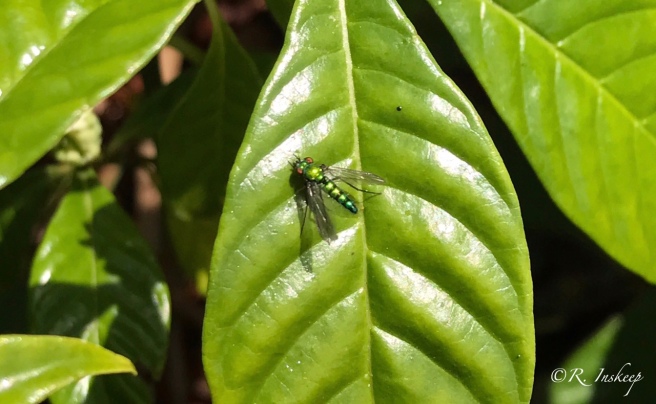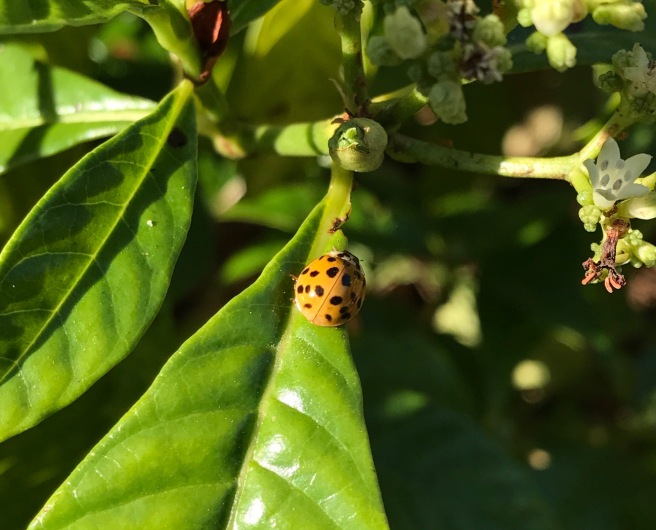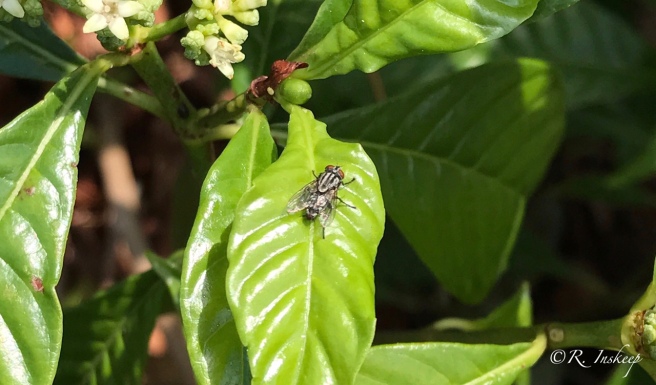








Many butterfly enthusiasts in Florida seek out Aristolochia (Pipevine) species to attract Pipevine Swallowtail and Polydamas Swallowtail butterflies to their garden. While their intentions are usually good, they often choose exotic Aristolochia species that are either detrimental to Pipevine Swallowtail larvae, or they choose an invasive species. These exotic Aristolochia species with a dark side are commonly available in the nursery trade. Many folks buy what is readily available and easily accessible to them. After all, plants do not come with labels that say “this species kills butterfly larvae”, or “this species is invasive”. I do, however, suspect that if people were aware of the consequences of using the exotic Aristolochia species highlighted in this article that they would avoid them. Now, on to the offenders!
ARISTOLOCHIA SPECIES TO AVOID:
Aristolochia gigantea (Pelican Flower) – This species can be toxic to Pipevine Swallowtail larvae. Not only has this been documented, but I have first-hand experience with this vine. Years ago, before I became an advocate for native plants, I planted Aristolochia gigantea. I was utterly excited because I was misinformed that this particular vine was a two for one, attracting both Pipevine Swallowtail and Polydamas Swallowtail butterflies. While this vine is palatable to Polydamas Swallowtail larvae, I would soon find Pipevine Swallowtails ovipositing (laying) their eggs on it, only to watch the young larvae perish after chewing their first meal. Alarmed that I had been luring them to my urban yard and straight into a death trap, I immediately removed the vine. Without question, this is counterproductive to attract one butterfly species to the demise of another.
Aristolochia elegans (Elegant Dutchman’s Pipe; Calico Flower) (synonym; Aristolochia littoralis) – Common names for this species include Calico Flower or Elegant Dutchman’s Pipe. While Aristolochia elegans is palatable for both Pipevine Swallow and Polydamas Swallowtail larvae, this species is a category II exotic invasive in Florida according to Florida Exotic Pest Plant Council. Any plant, rather it is a category I or II invasive species, should be avoided. University of Florida’s Center for Aquatic and Invasive Plants on the impact of Aristolochia elegans: “Calico flower has been shown to escape cultivation in many areas of the world, including Florida. It has the ability to weigh down native plants and cause collapse under of the mass of vegetation produced. This creates an opening for opportunistic weeds to invade and take over an area. When the winged seeds of Calico Flower are dispersed, they will germinate wherever they land. This species is difficult to control once established because of above and below ground stems and roots that require numerous herbicide applications.”
Aristolochia ringens (Gaping Dutchman’s Pipe) (basionym; Aristolochia grandiflora) – According to the assistant curator at Museum of Science and Industry (MOSI Outside) BioWorks Butterfly Garden Exhibit, Aristolochia ringens is toxic to Pipevine Swallowtail larvae.
FLORIDA NATIVE ARISTOLOCHIA SPECIES:
Aristolochia tomentosa (Woolly Dutchman’s Pipe) – Aristolochia tomentosa occurs in North Florida only in nine counties according to Atlas of Florida Plants. Growing this species in Central Florida or South Florida might be difficult because this vine is not adapted to the conditions in these regions. Here in my Sarasota County garden, I have found Aristolochia tomentosa to be extremely slow growing. I have tried growing this species several times. Each time, the plants grew to about 12 inches. They held on for about a year until they eventually withered away. Aristolochia tomentosa might also be tough to find in the native nursery trade, but not impossible. This is especially true in Central Florida and South Florida where this species is difficult to grow. However, if you want to throw caution to the wind, you can order Aristolochia tomentosa online from Mail Order Natives located in Lee, Florida. You may also inquire with the fine folks at your local Florida native plants nursery and they might be able to special order Aristolochia tomentosa for you.
Aristolochia serpentaria (Virginia Snakeroot) – Aristolochia serpentaria occurs in North Florida Escambia County to Central Florida Desoto and Highlands County according to Atlas of Florida Plants. This is the only native Aristolochia species that occurs in Central Florida to feed Pipevine Swallowtail larvae. This vine is more of a ground cover and each plant only grows to about 12 inches and sometimes up to 3 feet. You would need more than several plants to sustain an army of hungry Pipevine Swallowtail larvae. The gregarious larvae eat like there’s no tomorrow, so buy more than you think you need if you want to add this plant to your landscape. Aristolochia serpentaria is not easy to find in the native nursery trade, but it is worth seeking out. Ask your local Florida native plants nursery if they are able to special order this plant if they do not carry it.
Aristolochia pentandra (Marsh’s Dutchman’s Pipe) – Marsh’s Dutchman’s Pipe is endangered, critically imperiled and not cultivated for sale according to The Institute for Regional Conservation. This species occurs in Florida from Broward County south on the east coast only. View Aristolochia pentandra at Atlas of Florida Plants.
If you have found that you’ve exhausted all resources and can’t grow or find Florida Native Aristolochia at a Florida native plants nursery, it might be time to forgo the hunt. Plant Florida native wildflowers and you will see them visit your beautiful garden frequently.

Turkey Tangle Frogfruit, that is! Phyla nodiflora (Turkey Tangle Frogfruit) is a groundcover and is so common that it grows in every county in Florida, from wetlands to non-wetlands. P. nodiflora does, however, seem to prefer moist soils but is tolerant of drought once established. In our garden, Frogfruit grows in both moist and dry situations and is happiest where the ground stays moist longer, resulting in denser patches. In the areas where it stays mostly dry, the ground cover is sparse and does not live up to its full potential.

Not only is “Turkey Tangle Frogfruit” fun to say, it is a three for one larval host for Common Buckeye (Junonia coenia), Phaon Crescent (Phyciodes phaon) and White Peacock (Anartia jatrophae) butterflies. Several small butterfly species and other pollinators such as bees enjoy the nectar from the small flowers. Phyla nodiflora is easily propagated from cuttings or simply dug up from your lawn and relocated elsewhere in your landscape. It is not unusual to find Phyla nodiflora growing in residential lawns where some folks might not realize they already have it.

View the Phyla nodiflora (Turkey Tangle Frogfruit) plant profile at Florida Native Plant Society HERE!
Find Phyla nodiflora (Turkey Tangle Frogfruit) and other Florida native plants at a Florida native plants nursery by visiting Florida Association of Native Nurseries HERE!

Like bees, pollinating flies are beneficial. The Flower Flies, in the family Syrphidae (Syrphid), play an important outstanding role among all the flower flies. Some species of Syrphid Fly larvae feed on aquatic debris, rotting vegetation, moist or wet wood and bulbs of forbs of living plants, but most are predatory and several Syrphid species are important in controlling aphids or scale. This is nature’s pest control. Syrphid Fly larvae that live in water that contains a significant amount of decaying organic matter are sometimes referred to as “Rat-tailed Maggots” that have a long anal breathing tube allowing for survival. Some might not realize the importance of Diptera (flies) as pollinators and they are largely ignored when compared to other pollinators such as larger bees or butterflies. Syrphid flies do a double duty as pollinators while playing an important role in biological control.


We celebrate all arachnids (spiders) in our garden and the Leucauge argyra (Orchard Orb Weaver) is a welcome resident. Leucauge argyra can easily be confused with the similar looking Leucauge venusta. The abdomen of Leucauge venusta is typically more colorful with silver, yellow, black, green, and bright orange or pink spots. To compare the two, look here. Orchard Orb Weavers construct their webs rather close to the ground on small trees, shrubs or other vegetation. The mass of eggs is laid not far from the web and are usually found on nearby stems or leaves. It is quite entertaining to watch the little spiderlings hatch and scatter to make webs of their very own. Leucage argyra are harmless creatures and rarely do they bite. If they were to bite, their venom is weak and used to paralyze their small insect victims, not you or I. Most spiders do have venom, but very few are a danger to humans. Most spiders either won’t bite at all, hardly ever bite or if they do bite it causes no serious harm.



According to Atlas of Florida Plants Institute for Systematic Botany, Sunshine Mimosa occurs throughout the state north from Walton County and south to Miami-Dade with a possible spread to Timbuktu. This ground cover spreads by rhizomes that produce long tap roots at the nodes. Mimosa strigillosa is a legume (plant family: Fabaceae) and its roots can produce small knots associated with nitrogen-fixing bacteria that in turn, adds nitrogen to the soil. Because this plant spreads fast and forms a thick covering with long taproots that anchor themselves into the soil, it is an excellent choice for erosion control.

Choose wisely when deciding to add Sunshine mimosa to your landscape. It is best used away from flower beds because its many long taproots make it difficult to eradicate and will require frequent maintenance. Trying to pull out a taproot, you might find yourself in a tug-of-war match with a gardener from China on the other end. However, Sunshine Mimosa is not overly competitive when planted with grasses, shrubs and trees that are already established. Plant sunshine mimosa where it can freely spread and cover a large area or use it as a lawn alternative. Keep in mind that Sunshine Mimosa can spread several hundred feet in a short amount of time, possibly in one growing season.

Sunshine mimosa will go dormant late fall into spring and can leave the ground looking bare. Even in South Florida, the leaves can become yellow and look sparce. For this reason, we have intermingled native grasses throughout, such as Muhly Grass (Muhlenbergia capillaris) and Elliott’s Lovegrass (Eragrostis elliottii).

Mimosa strigillosa is easily propagated by taking tip cuttings and rooting them in a glass of water or placing them directly into potting soil. It is not difficult to find sections that have begun to set roots at the nodes in early summer or anytime during its growing season. These can also be potted up for some weeks until they are ready to transplant. Propagating by seed takes a little more patience. The seeds will turn an olive to brown color when they are ready to harvest. The seed coating is impervious to water so it should be scarified (rubbed using a nail file or lightly rubbed with sandpaper) to ensure germination.

Sunshine mimosa (Mimosa strigillosa) seeds may be purchased at Florida Wildflowers Growers Cooperative. Locating plants is not difficult and they are usually available at most Florida native plant nurseries. Find a nursery in your area at Florida Association of Native Nurseries.

Native plants bring in a wealth of living movement and Wild Coffee (Psychotria nervosa) is no exception. In just a short amount of time, a variety of insects can be observed on the plant. The spring blooms attract an assortment of butterflies, but below are some of the other pollinators and insects that enjoy this plant.

Native to the Neotropics and established in Florida, Zeta argillaceum are common in urban areas where they build their pots (nests) on the sides of buildings such as homes. Each “pot” contains one small entrance hole. A single egg is laid in each cell and the adult wasp fills the cell with paralyzed living food (commonly moth larvae of the genus Geometridae) for the emerging wasp larva to feed on. The nest is only used one time by Zeta argillaceum, but is often reused by other potter wasps such as Pachodynerus species.

The Dilemma Orchid Bee was first discovered in Broward County by entomologists working with the USDA fruit fly monitoring program. Like other Orchid Bees, Euglossa dilemma is relatively solitary, but will occasionally share nesting sites. Females build nest cells out of resins (propolis) collected from plant sources. Nests can be located in many different cavities and nest entrances are often sealed off by resin or other plant debris. The mother provides her young larvae with pollen and nectar while they develop. Like other bees, Orchid Bees play an important role in the pollination of plants.

Long-legged Fly (Condylostylus longicornis) is possibly the most widespread species of the genus Condylostylus in the order Diptera (Flies). The Long-legged Fly is a beneficial garden visitor. They aren’t your typical bothersome fly, so there is usually no need to swat these charming critters away. Adults are predators of mites, aphids, thrips, other flies, silverfish and small caterpillars to name several.

The sun illuminates the unmistakable shimmering color of the Sweat Bee (Agapostemon splendens) as they land on flowers to collect pollen. These native bees seem to prefer flowers in the Asteraceae (composite) family. In Central Florida, I usually see them in the warmer months of March through November gathering pollen from Gaillardia pulchella (Blanketflower), Bidens alba (Beggarticks) and Helianthus debilis (Dune Sunflower). Agapostemon splendens are ground nesting bees. Although they are considered solitary nesters, it is not unusual for females to share and allow other females to enter the nest. Male and female A. splendens are easy to tell apart. The male is more slender than females with a black and yellow striped abdomen. The female is plumper with an all green body. The female typically has darker wings while males are usually clearer. You can attract Sweat Bees and other native ground nesting bees to your landscape by planting Florida native wildflowers, especially those in the Asteraceae (Composite) family and by retaining areas of bare soil for nesting.

The Multicolored Asian Beetle is a non-native species and is either considered a pest or a welcome garden visitor as they feed on aphids, thripes, mites, lepidoptera (butterfly and moth) eggs and scale. They were introduced from Asia by humans for biological control and by accident. Lucky for the folks in South Florida, the Multicolored Asian Lady Beetle is not such a problem. In North Florida and other parts of the United States where the temperatures get cold during the winter is where they can become an issue when they overwinter in large numbers in house walls or other human dwellings. Read all about the native and non-native Ladybugs of Florida HERE.

Meet the Hairy Maggot Blow Fly (Chrysomya rufifacies). They were discovered in the United States around 1980 and is an exotic (not native) diptera (flies) species. C. rufifacies is used in forensics and like other flies, they are pollinators. This species needs rotten meat or decomposing carrion to complete its lifecycle. Thankfully there is not a rotting carcass in our landscape and the Wild Coffee is the attractor for this rather handsome fly. Want to know more about Chrysomya rufifacies, look HERE.

Here is a Red-tailed Flesh Fly (Sarcophaga haemorrhoidalis). The larvae of the Red-tailed Flesh Fly invade carcasses that are in the early to advanced stages of decomposition and is an important species used in forensics dealing with criminal and legal matters. Red-tailed Flesh Flies resemble the common house fly, but they are larger and more robust.

The Northen Paper Wasp (Polistes fuscatus) commonly inhabits woodlands and savannas. They are also common around urban areas where humans inhabit, especially where wood is present that can be used to nesting material. Adult Northern Paper Wasps feed primarily on plant nectar. They will kill caterpillars and other small insects by masticating them to feed their young. The solid portion of the meal is given to older larvae and the liquid is regurgitated and fed to younger larvae.


 A new beauty to grace our garden on the second day of spring. There is always something new to see in a native wildlife garden. This one was all about our Scorpion Tail (Heliotropium angiospermum). Black-winged Dahana is diurnal (day flying) and the only Dahana genus that occurs in North America according to Bugguide.net. Larval feed on Spanish Moss (Tillandsia usneoides).
A new beauty to grace our garden on the second day of spring. There is always something new to see in a native wildlife garden. This one was all about our Scorpion Tail (Heliotropium angiospermum). Black-winged Dahana is diurnal (day flying) and the only Dahana genus that occurs in North America according to Bugguide.net. Larval feed on Spanish Moss (Tillandsia usneoides).

Opuntia stricta (op-UN-shee-uh STRIK-tuh) is one of four native Opuntia species that occur in Florida. Erect Pricklypear grows north to south on the east and west coast and is quite common growing along coastal dunes, coastal grasslands, coastal hammocks and on shell mounds. The height of this species is variable but is typically around 2-4 feet with an equally variable spread of 1-4 feet. Opunta stricta makes an interesting plant in residential landscapes in hot, dry locations where other plants would be impossible to grow. Its use as a low growing, visually intriguing hedge is worth considering if kept away from areas that are frequently used, but would be ideal to keep intruders away.

The large, bright yellow flowers typically bloom around February into July and are very showy, attracting many pollinating insects including native bees. Ants are also attracted to Opuntia and in turn, protect against herbivores that might otherwise damage the plant. After flowering, the jewel-toned fruits will form and they also provide ornamental interest. These fruits are edible and enjoyed by birds and mammals, including humans. The seeds from the fruit are mainly dispersed by mammals and birds and can remain viable for up to a decade. The young pads are edible when the many thorns have been properly removed and may be eaten raw in a salad, alone or cooked in a number of creative ways.

The pads of Opuntia and other Cactaceae are not leaves, but in fact, stems. The pads contain eyes called areolas where the spikes emerge from. The spikes are technically modified leaves and very sharp. Besides the obvious large spikes, they also contain very fine hair-like spikes that can get embedded into your skin despite your best effort to be careful near the plant or while handling the pads or fruits. The areolas will grow roots if removed from the parent plant and can easily be propagated this way and the base of the pad will also root if placed on top of soil or sand.

Opuntia stricta is an example of a well-behaved plant in its native region, but one that is very invasive in other parts of the world. In 1925, the Cactus Moth (Cactoblastis cactorum) was introduced from Argentina to Australia to control Opuntia species that came from North America and South America. The Cactus Moth has since spread to the United States and is now a threat to our native Opuntia species.
